Dimensioning of Required Volumes of Interconnected Detention Tanks Taking into Account the Direction and Speed of Rain Movement
Abstract
1. Introduction
2. Materials and Methods
3. Results and Discussion
4. Conclusions
Author Contributions
Funding
Acknowledgments
Conflicts of Interest
Abbreviations
| Do | diameters of the outflow channels for tank, m; |
| QO | stormwater outflow from the tanks, dm3·s−1; |
| QA | stormwater inflow to the tanks, dm3·s−1; |
| QC | stormwater transport from the flow-through chamber KP to the accumulation chamber KA, dm3·s−1; |
| QD | stormwater outflow from the accumulation chamber KA to the flow-through chamber KP, dm3·s−1; |
| KA | accumulation chamber; |
| KP | flow-through chamber; |
| td | rainfall duration, min; |
| t | time that has elapsed since the beginning of the rainfall, min; |
| V | required volume of tank, m3; |
| Rv | percentage difference in required volume of tank between the static and dynamic conditions; |
| K | flowing direction of the wave of rainfall, -; |
| v | flowing velocity of the wave of rainfall, m·s−1; |
References
- Yuan, Z.; Xu, J.; Wang, Y. Projection of future extreme precipitation and flood changes of the Jinsha river basin in China based on CMIP5 climate model. Int. J. Environ. Res. Public Health 2018, 15, 2491. [Google Scholar] [CrossRef] [PubMed]
- Hettiarachchi, S.; Wasko, C.; Sharma, A. Increase in flood risk resulting from climate change in a developed urban watershed–the role of storm temporal patterns. Hydrol. Earth Syst. Sci. 2018, 22, 2041–2056. [Google Scholar] [CrossRef]
- Caporali, E.; Chiarello, V.; Petrucci, A. Regional frequency analysis and geoadditive modeling for design storm estimates in the Arno river basin (Italy). Environ. Ecol. Stat. 2018, 25, 31–52. [Google Scholar] [CrossRef]
- Calabro, P.S.; Viviani, G. Simulation of the operation of detention tanks. Water Res. 2006, 40, 83–90. [Google Scholar] [CrossRef] [PubMed]
- Raganowicz, A.; Dziopak, J.; Słyś, D. Realistic classification of stoneware sewerage network technical condition. In Underground Infrastructure of Urban Areas 3, 4th ed.; Madryas, C., Kolonko, A., Nienartowicz, B., Szot, A., Eds.; CRC Press: Boca Raton, FL, USA, 2014; Volume 1, pp. 223–236. ISBN 9781138026520. [Google Scholar]
- Słyś, D.; Dziopak, J. Development of Mathematical Model for Sewage Pumping-Station in the Modernized Combined Sewage System for the Town of Przemysl. Pol. J. Environ. Stud. 2011, 20, 743–753. [Google Scholar]
- Wang, J.; Guo, Y.P. An Analytical Stochastic Approach for Evaluating the Performance of Combined Sewer Overflow Tanks. Water Resour. Res. 2018, 54, 3357–3375. [Google Scholar] [CrossRef]
- Stec, A.; Mazur, A.; Słyś, D. Evaluating the financial efficiency of energy and water saving installations in passive house. E3S Web Conf. 2017, 22, 00168. [Google Scholar] [CrossRef]
- Słyś, D.; Stec, A.; Zeleňáková, M. Economic effect of the liquid soil technology compared to traditional sewage system construction methods. Environ. Eng. IV 2013, 1, 35–40. [Google Scholar]
- Stec, A. Hydrodynamic modeling of the impact of residential rainwater harvesting systems on stormwater runoff and drainage networks. E3S Web Conf. 2018, 45, 00089. [Google Scholar] [CrossRef]
- Kordana, S.; Słyś, D.; Dziopak, J. Rationalization of water and energy consumption in shower systems of single-family dwelling houses. J. Clean. Prod. 2014, 82, 58–69. [Google Scholar] [CrossRef]
- Todeschini, S.; Papiri, S.; Ciaponi, C. Performance of stormwater detention tanks for urban drainage systems in northern Italy. J. Environ. Manag. 2012, 101, 33–45. [Google Scholar] [CrossRef] [PubMed]
- Kaleta, J.; Kida, M.; Koszelnik, P.; Papciak, D.; Puszkarewicz, A.; Tchórzewska-Cieślak, B. The use of activated carbons for removing organic matter from groundwater. Arch. Environ. Prot. 2017, 43, 32–41. [Google Scholar] [CrossRef]
- Kida, M.; Ziembowicz, S.; Koszelnik, P. Removal of organochlorine pesticides (OCPs) from aqueous solutions using hydrogen peroxide, ultrasonic waves, and a hybrid proces. Sep. Purif. Technol. 2018, 192, 457–464. [Google Scholar] [CrossRef]
- Todeschini, S.; Papiri, S.; Ciaponi, C. Placement Strategies and Cumulative Effects of Wet-weather Control Practices for Intermunicipal Sewerage Systems. Water Resour. Manag. 2018, 32, 2885–2900. [Google Scholar] [CrossRef]
- Stec, A. Rainwater harvesting and greywater recycling as alternative water resources: A survey of public opinion. E3S Web Conf. 2018, 45, 00090. [Google Scholar] [CrossRef]
- Ogden, F.L.; Sharif, H.O.; Senarath, S.U.S.; Smith, J.A.; Baeck, M.L.; Richardson, J.R. Hydrologic analysis of the Fort Collins, Colorado, flash flood of 1997. J. Hydrol. 2000, 228, 82–100. [Google Scholar] [CrossRef]
- Berne, A.; Delrieu, G.; Creutin, J.D.; Obled, C. Temporal and spatial resolution of rainfall measurements required for urban hydrology. J. Hydrol. 2004, 299, 166–179. [Google Scholar] [CrossRef]
- Zambrano, F.; Wardlow, B.; Tadesse, T.; Lillo-Saavedra, M.; Lagos, O. Evaluating satellite-derived long-term historical precipitation datasets for drought monitoring in Chile. Atmos. Res. 2017, 186, 26–42. [Google Scholar] [CrossRef]
- Zelenakova, M.; Purcz, P.; Blist’an, P.; Vranayova, Z.; Hlavata, H.; Diaconu, D.C.; Portela, M.M. Trends in Precipitation and Temperatures in Eastern Slovakia (1962–2014). Water 2018, 10, 727. [Google Scholar] [CrossRef]
- Barbero, G.; Moisello, U.; Todeschini, S. Evaluation of the Areal Reduction Factor in an Urban Area through Rainfall Records of Limited Length: A Case Study. J. Hydrol. Eng. 2014, 19, 05014016. [Google Scholar] [CrossRef]
- Zawilski, M.; Brzezińska, A. Areal rainfall intensity distribution over an urban area and its effect on a combined sewerage system. Urban Water J. 2014, 11, 532–542. [Google Scholar] [CrossRef]
- Liang, J.; Melching, C.S. Experimental evaluation of the effect of storm movement on peak discharge. Int. J. Sediment Res. 2015, 30, 167–177. [Google Scholar] [CrossRef]
- Isidoro, J.M.G.P.; De Lima, J.L.M.P. Laboratory simulation of the influence of building height and storm movement on the rainfall run-off process in impervious areas. J. Flood Risk Manag. 2014, 7, 176–181. [Google Scholar] [CrossRef]
- Willems, P.; Berlamont, J. Probabilistic emission and immission modelling: Case-study of the combined sewer—WWTP—Receiving water system at Dessel (Belgium). Water Sci. Technol. 2002, 45, 117–124. [Google Scholar] [CrossRef] [PubMed]
- Starzec, M.; Dziopak, J.; Słyś, D. Designing a retention sewage canal with consideration of the dynamic movement of precipitation over the selected urban catchment. In Underground Infrastructure of Urban Areas 4, 4th ed.; Madryas, C., Kolonko, A., Nienartowicz, B., Szot, A., Eds.; CRC Press: London, UK, 2017; Volume 1, pp. 193–200. ISBN 9781138559530. [Google Scholar]
- Pochwat, K.; Słyś, D.; Kordana, S. The temporal variability of a rainfall synthetic hyetograph for the dimensioning of stormwater retention tanks in small urban catchments. J. Hydrol. 2017, 549, 501–511. [Google Scholar] [CrossRef]
- Pochwat, K. Hydraulic analysis of functioning of the drainage channel with increased retention capacity. E3S Web Conf. 2017, 17, 00075. [Google Scholar] [CrossRef]
- Pochwat, K.; Iličić, K. A simplified dimensioning method for high-efficiency retention tanks. E3S Web Conf. 2018, 45, 00065. [Google Scholar] [CrossRef]
- Meneses, E.J.; Gaussens, M.; Jakobsen, C.; Mikkelsen, P.S.; Grum, M.; Vezzaro, L. Coordinating Rule-Based and System-Wide Model Predictive Control Strategies to Reduce Storage Expansion of Combined Urban Drainage Systems: The Case Study of Lundtofte, Denmark. Water 2018, 10, 76. [Google Scholar] [CrossRef]
- Pochwat, K. The use of artificial neural networks for analyzing the sensitivity of a retention tank. E3S Web Conf. 2018, 45, 00066. [Google Scholar] [CrossRef]
- Dziopak, J. A wastewater retention canal as a sewage network and accumulation reservoir. E3S Web Conf. 2018, 45, 00016. [Google Scholar] [CrossRef]
- AMEC Environment Infrastructure. Development of Projected Intensity–Duration–Frequency Curves for Welland, Ontario, Canada (Final Report), National Engineering Vulnerability Assessment of Public Infrastructure to Climate Change City of Welland Stormwater and Wastewater Infrastructure. 2012. Available online: https://www.welland.ca/Eng/pdfs/AppC-WellandReportFinal.pdf (accessed on 9 December 2018).
- Elsebaie, I.H. Developing rainfall intensity-duration-frequency relationship for two regions in Saudi Arabia. J. King Saud Univ. 2012, 24, 131–140. [Google Scholar] [CrossRef]
- Bogdanowicz, E.; Stachy, J. Maximum Rainfall in Poland. Design Characteristics, 1st ed.; The Publishing House of the Institute of Meteorology and Water Management: Warsaw, Poland, 1998; p. 83. [Google Scholar]

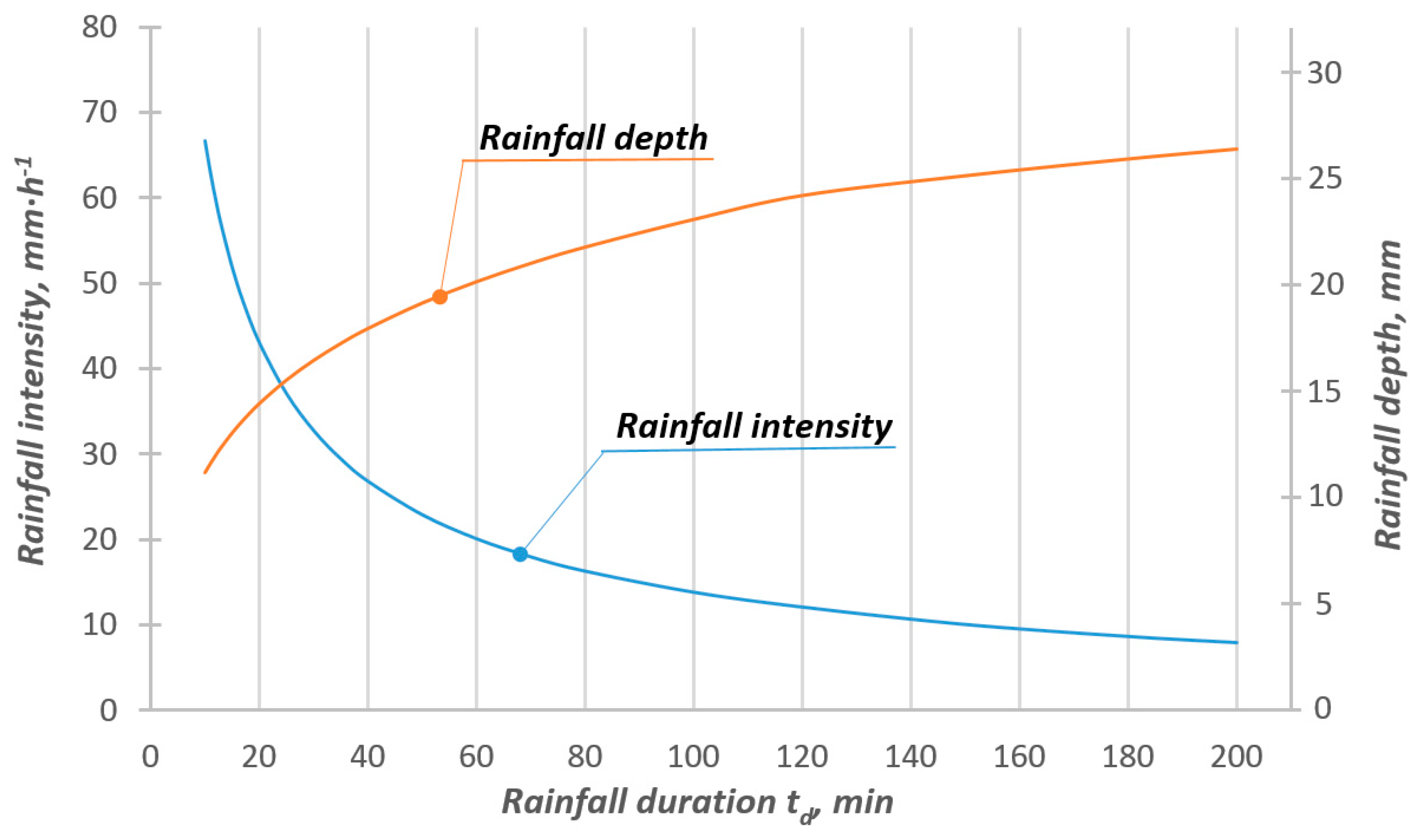
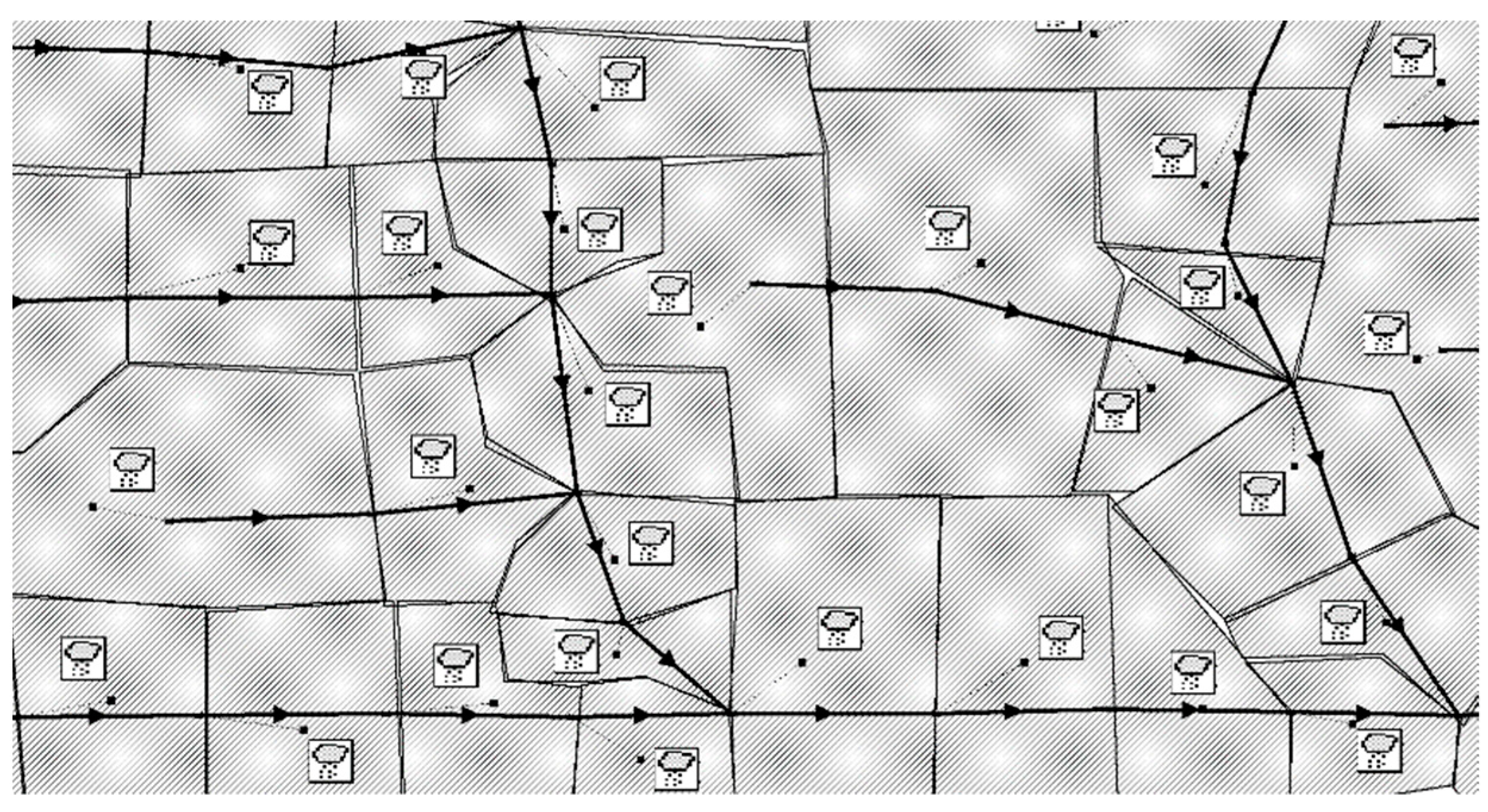

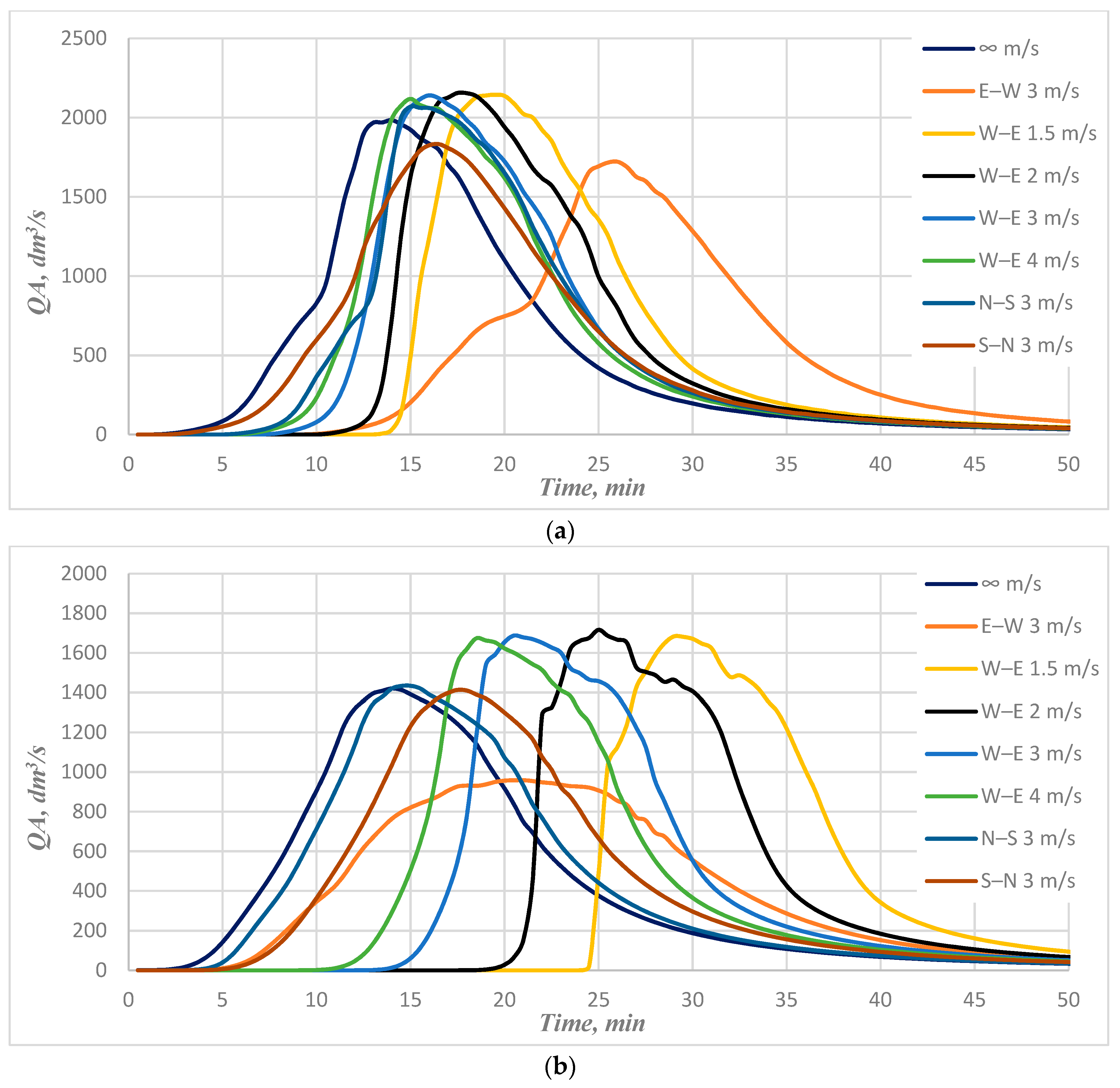
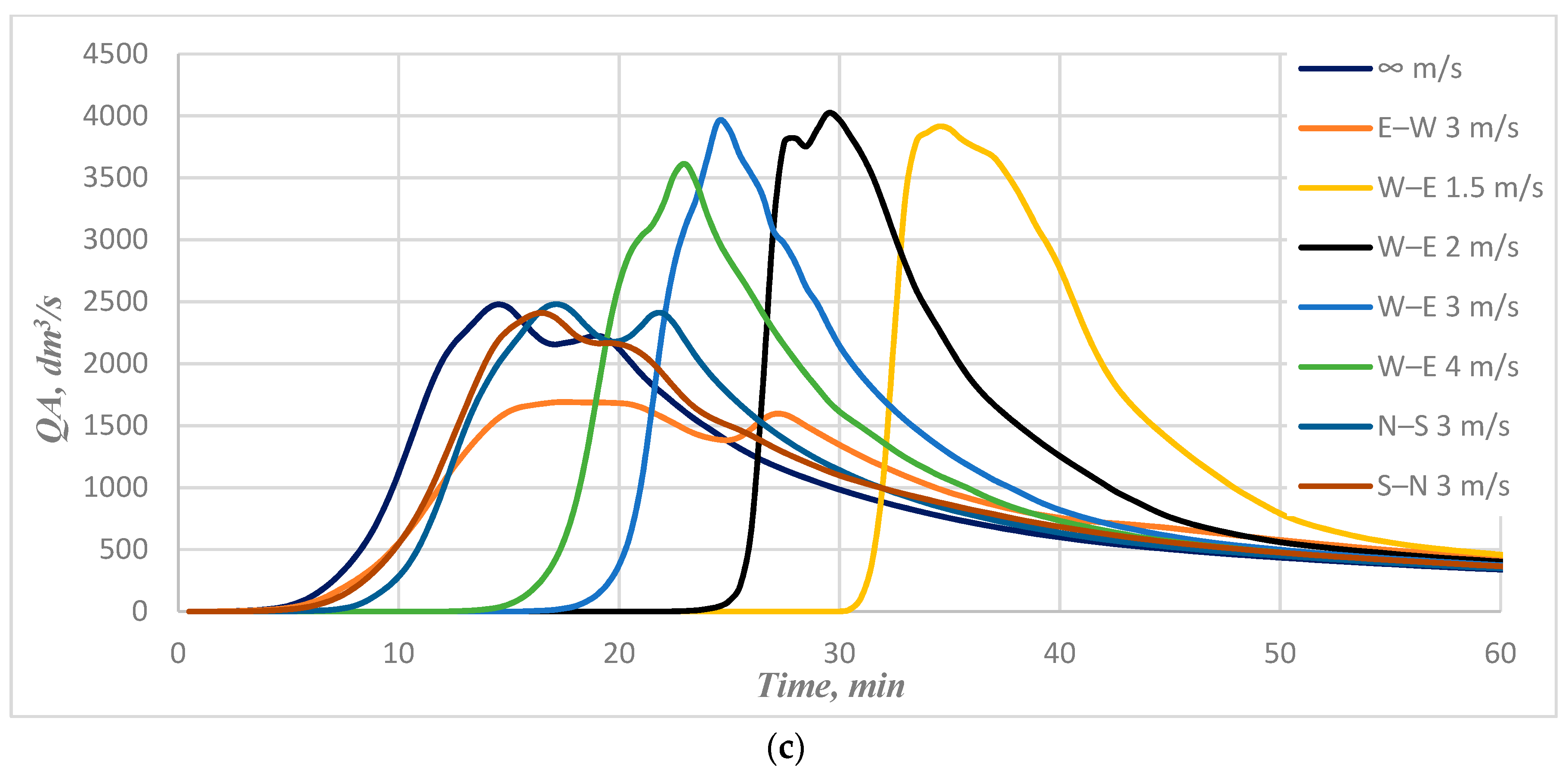
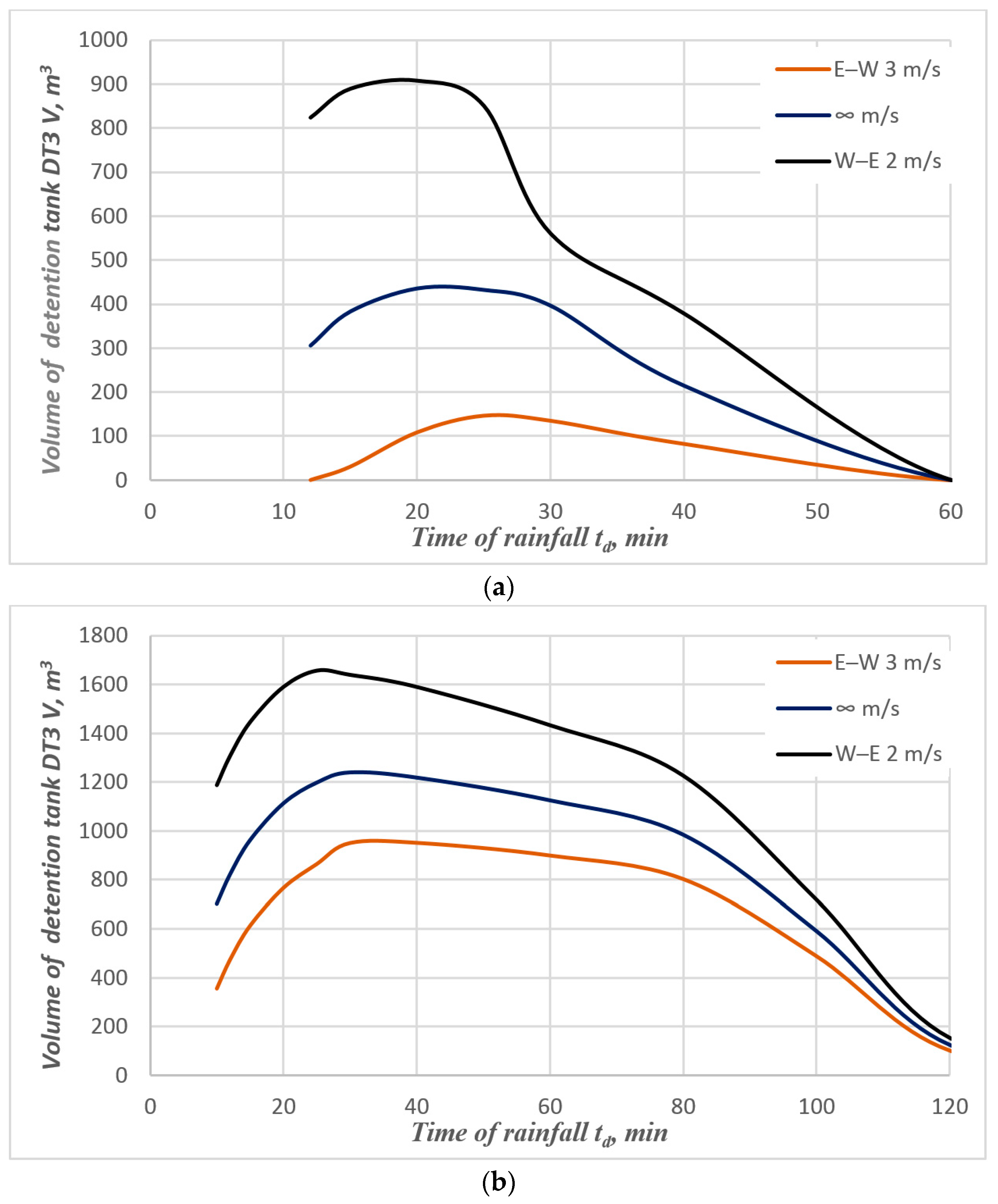
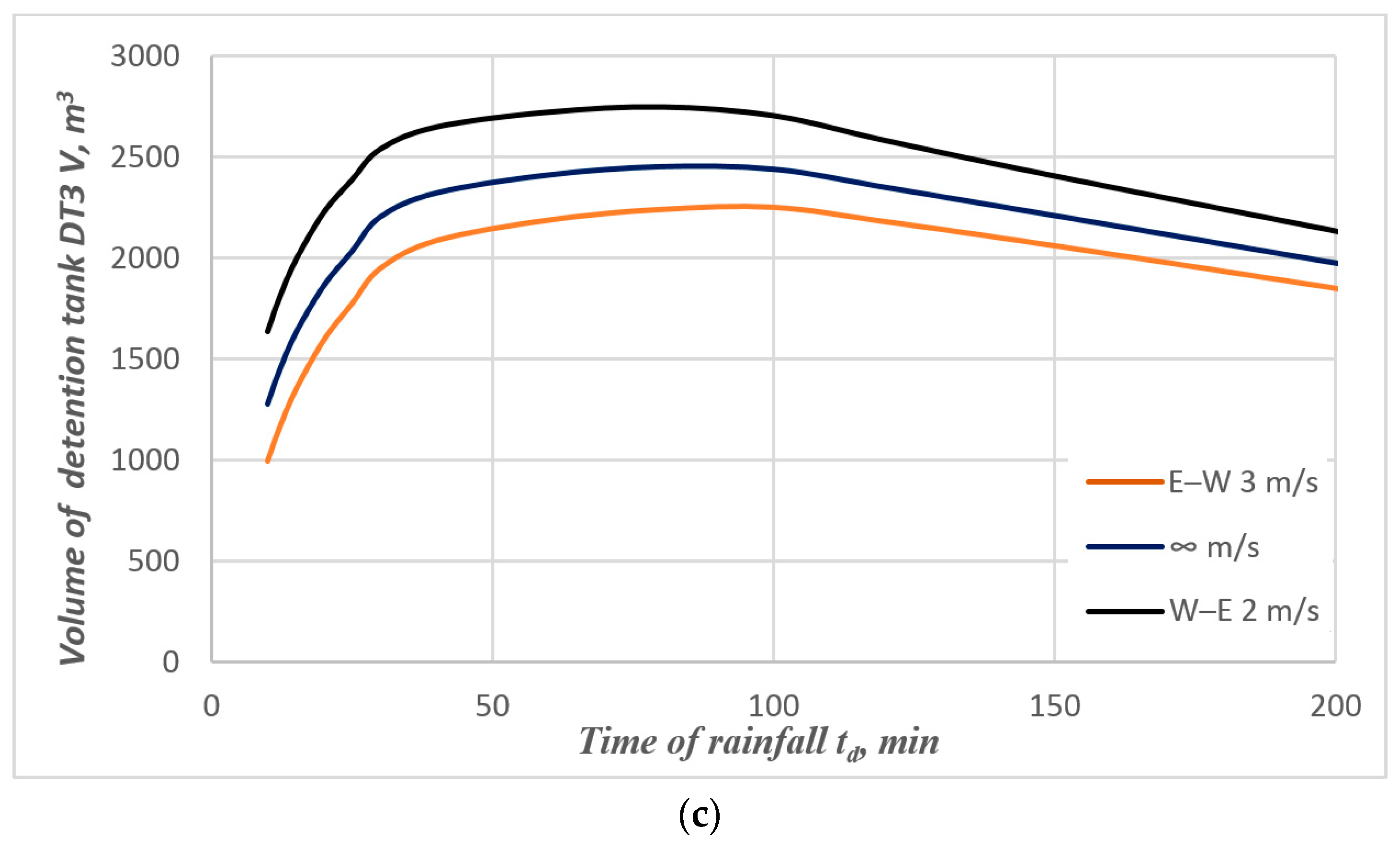
| Detention Tank DT3 | |||||||
|---|---|---|---|---|---|---|---|
| DO for DT1 and DT2 | Static Conditions v = ∞ m·s−1 | Dynamic Conditions | |||||
| Maximum Peak Stormwater Flow Rates QA | |||||||
| QA | td | QA | td | K | v | RV | |
| [m] | [dm3·s−1] | [min] | [dm3·s−1] | [min] | [–] | [m·s−1] | [%] |
| 0.7 | 3987.87 | 20.0 | 5189.66 | 10.0 | W–E | 2.0 | 30.14 |
| 0.5 | 3305.39 | 20.0 | 4552.83 | 10.0 | W–E | 2.0 | 37.74 |
| 0.3 | 2757.19 | 20.0 | 4023.02 | 10.0 | W–E | 2.0 | 45.91 |
| Minimum peak stormwater flow rates QA | |||||||
| 0.7 | 3987.87 | 20.0 | 3281.85 | 30.0 | E–W | 3.0 | −17.70 |
| 0.5 | 3305.39 | 20.0 | 2646.67 | 27.0 | E–W | 3.0 | −19.93 |
| 0.3 | 2757.19 | 20.0 | 2239.36 | 25.0 | E–W | 3.0 | −18.78 |
| Detention tank DT1 | |||||||
| Maximum peak stormwater flow rates QA | |||||||
| 1983.86 | 10.0 | 2155.21 | 10.0 | W–E | 2.0 | 8.63 | |
| Minimum peak stormwater flow rates QA | |||||||
| 1983.86 | 10.0 | 1732.46 | 12.0 | E–W | 3.0 | −12.76 | |
| Detention tank DT2 | |||||||
| Maximum peak stormwater flow rates QA | |||||||
| 1486.25 | 14.0 | 1716.32 | 10.0 | W–E | 2.0 | 15.48 | |
| Minimum peak stormwater flow rates QA | |||||||
| 1486.25 | 14.0 | 1193.02 | 22.0 | E–W | 3.0 | −19.73 | |
| Detention Tanks DT1 | ||||||
|---|---|---|---|---|---|---|
| Speed of Rain Movement v, m·s−1 | Diameter of the Outflow Channel Do, m | Max Stormwater Outflow Rate QO, dm3·s−1 | Required Useable Volumes of Detention Tank DT V, m3 | |||
| Direction of the Wave of Precipitation | ||||||
| W–E | E–W | N–S | S–N | |||
| ∞ | 0.3 | 200.0 | 1694.88 | |||
| 0.5 | 500.0 | 940.56 | ||||
| 0.7 | 875.0 | 498.48 | ||||
| 1.5 | 0.3 | 200.0 | 1689.78 | X | X | X |
| 0.5 | 500.0 | 982.224 | X | X | X | |
| 0.7 | 875.0 | 561.876 | X | X | X | |
| 2.0 | 0.3 | 200.0 | 1727.04 | X | X | X |
| 0.5 | 500.0 | 1007.04 | X | X | X | |
| 0.7 | 875.0 | 585.6 | X | X | X | |
| 3.0 | 0.3 | 200.0 | 1715.88 | 1683 | 1719.12 | 1685.52 |
| 0.5 | 500.0 | 988.08 | 872.28 | 961.44 | 914.64 | |
| 0.7 | 875.0 | 568.44 | 402.24 | 528 | 452.52 | |
| 4.0 | 0.3 | 200.0 | 1712.28 | X | X | X |
| 0.5 | 500.0 | 976.68 | X | X | X | |
| 0.7 | 875.0 | 553.8 | X | X | X | |
| 6.0 | 0.3 | 200.0 | 1709.16 | 1685.04 | 1710.24 | 1687.44 |
| 0.5 | 500.0 | 966.72 | 890.64 | 949.44 | 924.72 | |
| 0.7 | 875.0 | 540.24 | 427.32 | 519.36 | 469.8 | |
| 12.0 | 0.3 | 200.0 | 1703.88 | 1690.68 | 1701.84 | 1691.04 |
| 0.5 | 500.0 | 959.4 | 915 | 947.04 | 931.56 | |
| 0.7 | 875.0 | 519.48 | 454.2 | 512.88 | 483 | |
| Detention tanks DT2 | ||||||
| ∞ | 0.3 | 175.0 | 1376.5 | |||
| 0.5 | 345.0 | 727.8 | ||||
| 0.7 | 750.0 | 353.1 | ||||
| 1.5 | 0.3 | 175.0 | 1398.1 | X | X | X |
| 0.5 | 345.0 | 829.5 | X | X | X | |
| 0.7 | 750.0 | 485.4 | X | X | X | |
| 2.0 | 0.3 | 175.0 | 1410.2 | X | X | X |
| 0.5 | 345.0 | 836.2 | X | X | X | |
| 0.7 | 750.0 | 499.0 | X | X | X | |
| 3.0 | 0.3 | 175.0 | 1400.1 | 1333.5 | 1377.6 | 1374.6 |
| 0.5 | 345.0 | 810.5 | 626.6 | 731.2 | 724.2 | |
| 0.7 | 750.0 | 470.7 | 218.4 | 359.9 | 347.2 | |
| 4.0 | 0.3 | 175.0 | 1392.6 | X | X | X |
| 0.5 | 345.0 | 783.1 | X | X | X | |
| 0.7 | 750.0 | 452.6 | X | X | X | |
| 6.0 | 0.3 | 175.0 | 1385.7 | 1345.9 | 1377.0 | 1375.2 |
| 0.5 | 345.0 | 761.6 | 659.9 | 729.9 | 726.0 | |
| 0.7 | 750.0 | 419.7 | 249.6 | 357.2 | 349.6 | |
| 12.0 | 0.3 | 175.0 | 1379.6 | 1361.6 | 1376.9 | 1385.7 |
| 0.5 | 345.0 | 746.9 | 691.2 | 728.6 | 761.6 | |
| 0.7 | 750.0 | 388.6 | 299.7 | 354.9 | 419.7 | |
| Detention Tanks DT3 | |||||||
|---|---|---|---|---|---|---|---|
| Speed of Rain Movement v, m·s−1 | Diameter of the Outflow Channel Do, m | Max Stormwater Outflow Rate QO, dm3·s−1 | Required Useable Volumes of Detention Tank DT3 V, m3 | ||||
| Direction of the Wave of Precipitation | |||||||
| W–E | E–W | N–S | S–N | ||||
| ∞ | 0.5 | 750.0 | 2453.39 | ||||
| 0.65 | 1210.0 | 1241.19 | |||||
| 0.8 | 1825.0 | 435.24 | |||||
| 1.5 | 0.5 | 750.0 | 2679.25 | X | X | X | |
| 0.65 | 1210.0 | 1575.24 | X | X | X | ||
| 0.8 | 1825.0 | 824.69 | X | X | X | ||
| 2.0 | 0.5 | 750.0 | 2749.01 | X | X | X | |
| 0.65 | 1210.0 | 1657.12 | X | X | X | ||
| 0.8 | 1825.0 | 907.05 | X | X | X | ||
| 3.0 | 0.5 | 750.0 | 2687.12 | 2253.12 | 2478.82 | 2422.37 | |
| 0.65 | 1210.0 | 1589.23 | 951.13 | 1282.05 | 1197.50 | ||
| 0.8 | 1825.0 | 834.26 | 147.23 | 483.29 | 381.19 | ||
| 4.0 | 0.5 | 750.0 | 2606.86 | X | X | X | |
| 0.65 | 1210.0 | 1454.50 | X | X | X | ||
| 0.8 | 1825.0 | 693.13 | X | X | X | ||
| 6.0 | 0.5 | 750.0 | 2555.63 | 2341.27 | 2469.26 | 2430.58 | |
| 0.65 | 1210.0 | 1384.71 | 1050.23 | 1268.26 | 1218.52 | ||
| 0.8 | 1825.0 | 610.85 | 298.75 | 462.38 | 402.23 | ||
| 12.0 | 0.5 | 750.0 | 2505.89 | 2378.25 | 2462.31 | 2441.23 | |
| 0.65 | 1210.0 | 1325.68 | 1154.28 | 1252.89 | 1232.57 | ||
| 0.8 | 1825.0 | 536.81 | 345.69 | 449.26 | 421.59 | ||
| Detention Tanks DT3 | ||||||
|---|---|---|---|---|---|---|
| Speed of Rain Movement v, m·s−1 | Diameter of the Outflow Channel Do, m | Max Stormwater Outflow Rate QO, dm3·s−1 | Required Useable Volumes of Detention Tank DT3 V, m3 | |||
| Direction of the Wave of Precipitation | ||||||
| W–E | E–W | N–S | S–N | |||
| ∞ | 0.5 | 750.0 | 5286.74 | |||
| 0.65 | 1210.0 | 2686.67 | ||||
| 0.8 | 1825.0 | 1035.57 | ||||
| 1.5 | 0.5 | 750.0 | 5611.57 | X | X | X |
| 0.65 | 1210.0 | 2987.26 | X | X | X | |
| 0.8 | 1825.0 | 1478.56 | X | X | X | |
| 2.0 | 0.5 | 750.0 | 5645.07 | X | X | X |
| 0.65 | 1210.0 | 3055.12 | X | X | X | |
| 0.8 | 1825.0 | 1575.45 | X | X | X | |
| 3.0 | 0.5 | 750.0 | 5621.42 | 5010.40 | 5301.24 | 5266.83 |
| 0.65 | 1210.0 | 2998.46 | 2402.02 | 2711.65 | 2654.75 | |
| 0.8 | 1825.0 | 1489.32 | 697.86 | 1081.32 | 999.54 | |
| 4.0 | 0.5 | 750.0 | 5478.31 | X | X | X |
| 0.65 | 1210.0 | 2886.71 | X | X | X | |
| 0.8 | 1825.0 | 1311.79 | X | X | X | |
| 6.0 | 0.5 | 750.0 | 5415.65 | 5110.24 | 5296.23 | 5275.16 |
| 0.65 | 1210.0 | 2821.64 | 2514.56 | 2701.25 | 2667.25 | |
| 0.8 | 1825.0 | 1223.78 | 867.26 | 1059.87 | 1018.38 | |
| 12.0 | 0.5 | 750.0 | 5345.12 | 5201.24 | 5290.13 | 5281.45 |
| 0.65 | 1210.0 | 2784.23 | 2612.84 | 2692.54 | 2678.26 | |
| 0.8 | 1825.0 | 1156.28 | 926.23 | 1047.26 | 1029.68 | |
| Detention Tanks DT3 | ||||||
|---|---|---|---|---|---|---|
| Speed of Rain Movement v, m·s−1 | Diameter of the Outflow Channel Do, m | Max Stormwater Outflow Rate QO, dm3·s−1 | Required Useable Volumes of Detention Tank DT3 V, m3 | |||
| Direction of the Wave of Precipitation | ||||||
| W–E | E–W | N–S | S–N | |||
| ∞ | 0.5 | 750.0 | 5780.033 | |||
| 0.65 | 1210.0 | 4072.23 | ||||
| 0.8 | 1825.0 | 2341.23 | ||||
| 1.5 | 0.5 | 750.0 | 6098.56 | X | X | X |
| 0.65 | 1210.0 | 4577.26 | X | X | X | |
| 0.8 | 1825.0 | 2796.23 | X | X | X | |
| 2.0 | 0.5 | 750.0 | 6196.18 | X | X | X |
| 0.65 | 1210.0 | 4658.50 | X | X | X | |
| 0.8 | 1825.0 | 2917.30 | X | X | X | |
| 3.0 | 0.5 | 750.0 | 6102.35 | 5468.45 | 5804.21 | 5747.49 |
| 0.65 | 1210.0 | 4587.56 | 3603.18 | 4104.13 | 4038.84 | |
| 0.8 | 1825.0 | 2802.26 | 1854.70 | 2371.06 | 2301.15 | |
| 4.0 | 0.5 | 750.0 | 6004.72 | X | X | X |
| 0.65 | 1210.0 | 4403.05 | X | X | X | |
| 0.8 | 1825.0 | 2677.35 | X | X | X | |
| 6.0 | 0.5 | 750.0 | 5930.06 | 5584.23 | 5791.29 | 5759.23 |
| 0.65 | 1210.0 | 4298.16 | 3715.42 | 4081.24 | 4048.56 | |
| 0.8 | 1825.0 | 2572.21 | 2098.23 | 2354.23 | 2318.51 | |
| 12.0 | 0.5 | 750.0 | 5845.23 | 5678.23 | 5788.16 | 5769.13 |
| 0.65 | 1210.0 | 4187.47 | 3889.49 | 4074.29 | 4061.27 | |
| 0.8 | 1825.0 | 2489.56 | 2153.26 | 2347.26 | 2331.26 | |
| Detention Tanks DT3 | ||||||
|---|---|---|---|---|---|---|
| Diameter of the Outflow Channel Do from Detention Tank, m | Required Useable Volumes of Detention Tank DT3 | Percentage Differences Rv | ||||
| DT1, DT2 | DT3 | Statics Conditions | Dynamic Conditions | [%] | ||
| V, [m3] | td, [min] | V, [m3] | td, [min] | |||
| 0.3 | 0.5 | 2453.39 | 90 | 2749.01 | 80 | 12.05 |
| 0.65 | 1241.19 | 30 | 1657.12 | 25 | 33.51 | |
| 0.8 | 435.24 | 25 | 907.05 | 20 | 108.41 | |
| 0.5 | 0.5 | 5286.74 | 130 | 5645.07 | 120 | 6.78 |
| 0.65 | 2686.67 | 110 | 3055.12 | 100 | 13.71 | |
| 0.8 | 1035.57 | 30 | 1575.45 | 25 | 52.13 | |
| 0.7 | 0.5 | 5780.03 | 90 | 6196.18 | 80 | 7.20 |
| 0.65 | 4072.23 | 70 | 4658.50 | 60 | 14.40 | |
| 0.8 | 2341.23 | 70 | 2917.30 | 60 | 24.61 | |
© 2018 by the authors. Licensee MDPI, Basel, Switzerland. This article is an open access article distributed under the terms and conditions of the Creative Commons Attribution (CC BY) license (http://creativecommons.org/licenses/by/4.0/).
Share and Cite
Starzec, M.; Dziopak, J.; Słyś, D.; Pochwat, K.; Kordana, S. Dimensioning of Required Volumes of Interconnected Detention Tanks Taking into Account the Direction and Speed of Rain Movement. Water 2018, 10, 1826. https://doi.org/10.3390/w10121826
Starzec M, Dziopak J, Słyś D, Pochwat K, Kordana S. Dimensioning of Required Volumes of Interconnected Detention Tanks Taking into Account the Direction and Speed of Rain Movement. Water. 2018; 10(12):1826. https://doi.org/10.3390/w10121826
Chicago/Turabian StyleStarzec, Mariusz, Józef Dziopak, Daniel Słyś, Kamil Pochwat, and Sabina Kordana. 2018. "Dimensioning of Required Volumes of Interconnected Detention Tanks Taking into Account the Direction and Speed of Rain Movement" Water 10, no. 12: 1826. https://doi.org/10.3390/w10121826
APA StyleStarzec, M., Dziopak, J., Słyś, D., Pochwat, K., & Kordana, S. (2018). Dimensioning of Required Volumes of Interconnected Detention Tanks Taking into Account the Direction and Speed of Rain Movement. Water, 10(12), 1826. https://doi.org/10.3390/w10121826








